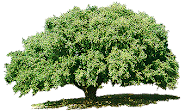THE ARGAN tree (argania spinosa) is perfect for a harsh environment, surviving heat, drought and poor soil.
It is little known outside Morocco, and many Moroccans themselves have never heard of it because it grows only in the south-west of the country - roughly between Essaouira and Agadir, in an area covering 700,000-800,000 hectares. But within the area where the argan grows there are about 21 million trees which play a vital role in the food chain and the environment, though their numbers are declining.
The tree, which is thorny and can reach heights of 8-10 metres, probably originated in Argana, a village north-east of Agadir (off Route 40). It lives longer than the olive and requires no cultivation.
The trunk of the argan is often twisted and gnarled, allowing goats to clamber along its branches and feed on the leaves and fruit.
The fruit has a green, fleshy exterior like an olive, but larger and rounder. Inside, there is a nut with an extremely hard shell, which in turn contains one, two or three almond-shaped kernels.
When goats eat the fruit, the fleshy part is digested but the nut remains. Later, the nuts are collected by farmers to produce oil.
The production of argan oil, which is still mostly done by traditional methods, is a lengthy process. Each nut has to be cracked open to remove the kernels, and it is said that producing one litre of oil takes 20 hours' work.
Argan oil is slightly darker than olive oil, with a reddish tinge. It can be used for cooking and is claimed to have various medicinal properties, such as lowering cholesterol levels, stimulating circulation and strengthening the body’s natural defences. Internationally, there is some interest in its possible cosmetic uses.
The residue from the kernels after oil extraction is a thick chocolate-coloured paste called "amlou" which is sweetened and served as a dip for bread at breakfast time in Berber households. It flavour is similar to that of peanut butter.
The wood and nut-shells of the argan tree are burned for cooking; the wood is also used decoratively in some of the inlaid boxes which are made in Essaouira. The roots of the argan tree grow deep in search of water, helping to bind the soil and prevent erosion.
Households that make their own argan oil tend to use if for general cooking. Because it is expensive to buy, others may use it more sparingly - flavouring salads, for example. A few drops stirred into couscous just before serving give it a rich, nutty aroma.
Argan production is still basically a cottage industry, managed largely by women. But many people believe that if the oil became better known it could provide more employment in the region as well as enhancing the environment.
Bottles of what pass for argan oil are sold along the roadsides between Essouira and Agadir, but is difficult to tell if they are genuine. Because the oil commands a high price, sellers are often tempted to dilute it with cheaper oils. Some bottles simply contain olive oil, coloured with paprika or other substances.










 21:32
21:32
 huile d'argane agadir
huile d'argane agadir







0 commentaires:
Enregistrer un commentaire